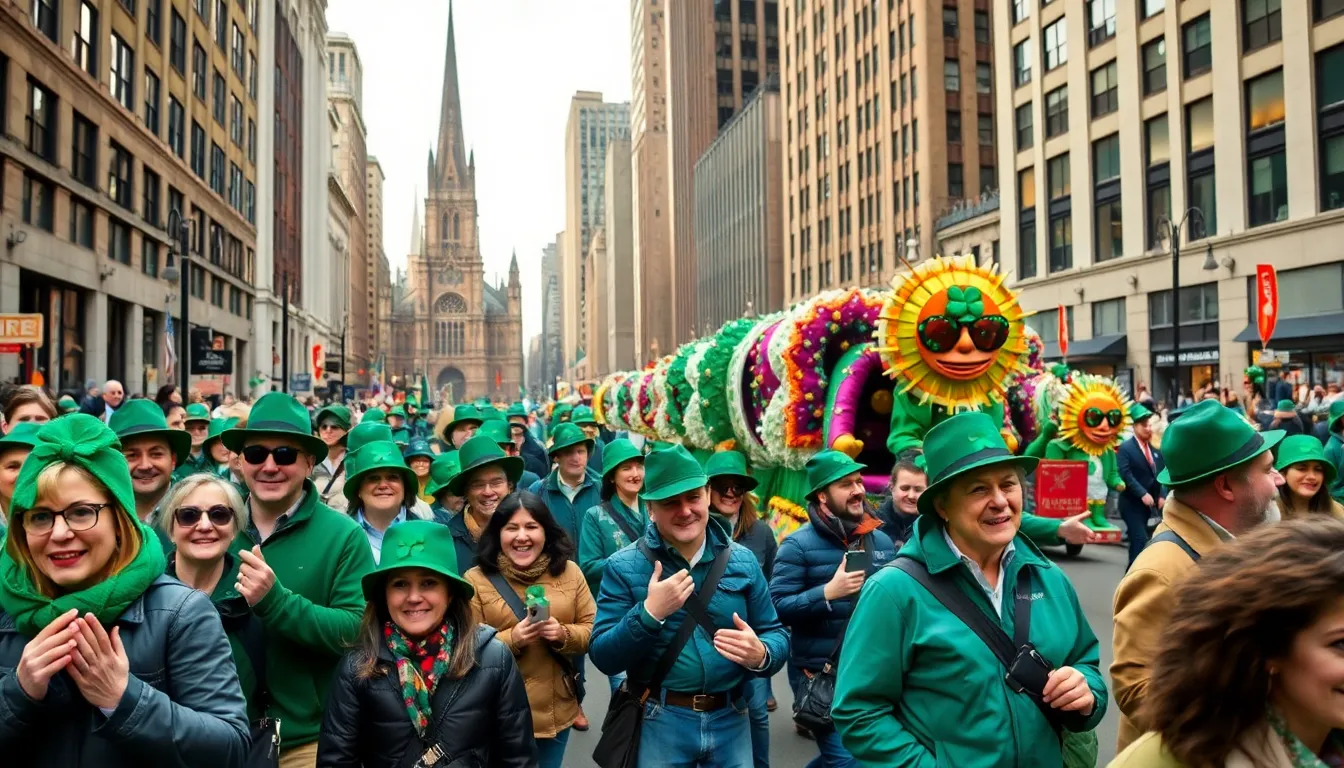Every year, the streets of New York City transform into a sea of green, as revelers don their best shamrocks and celebrate St. Patrick’s Day with gusto. The iconic St. Patrick’s Day Parade isn’t just an event; it’s a vibrant spectacle that draws thousands of enthusiastic participants and spectators alike. But before anyone can join the fun, they need to know the route.
Table of Contents
ToggleOverview of St. Patrick’s Day Parade
Annually, the St. Patrick’s Day Parade in New York City celebrates Irish culture and heritage. Thousands participate, showcasing vibrant floats, marching bands, and colorful costumes. The event attracts over two million spectators eager to view the procession along Fifth Avenue.
Every year, the parade features a diverse lineup of participants. Irish organizations, local schools, and cultural groups take part. Troops of bagpipers and drummers often lead the festivities, adding to the parade’s lively atmosphere.
Crowds gather early, eager to secure the best viewing spots along the route. The parade typically starts at 11 AM, running from 44th Street to 79th Street. A ceremonial mass at St. Patrick’s Cathedral marks the occasion, emphasizing the day’s significance.
Attendees often dress in green, displaying shamrocks and other Irish symbols. Excitement fills the air as families, friends, and tourists join the festivities. The parade’s lively energy creates an unforgettable experience.
Each year brings slight variations in the route map. Participants can check official resources for updates and alterations. Planning ahead enhances the day, ensuring revelers won’t miss any of the action.
History of the Parade

The St. Patrick’s Day Parade in New York City boasts a rich history celebrating Irish culture and heritage. Established in 1762, it ranks as one of the oldest parades in the world.
Origins and Tradition
Tradition began when Irish soldiers in the British Army marched through New York City to honor their homeland. The celebration gained momentum over the years, becoming a symbol of pride for Irish immigrants. Participants donned green attire and shamrocks to signify their connection to Ireland. Over time, the parade evolved into a grand event, featuring marching bands and vibrant floats, showcasing Irish culture. Each year, it draws people of diverse backgrounds, all united in appreciation of Irish heritage.
Notable Historical Events
Significant milestones shaped the St. Patrick’s Day Parade into the event it is today. In 1903, the parade gained official recognition, establishing it as a civic event rather than just a religious observance. The decision to hold the event on March 17th, coinciding with the Feast of St. Patrick, solidified its connection to Irish culture. During the 1980s and 1990s, the acceptance of LGBTQ+ groups revolutionized participation in the parade, increasing inclusivity. Numerous iconic figures, including mayors and celebrities, have led the procession, bringing attention to its importance. Each year, these remarkable moments contribute to the parade’s legacy and enduring popularity.
Parade Route Details
The St. Patrick’s Day Parade in New York City follows a vibrant route filled with excitement and culture. It offers a unique experience as attendees celebrate Irish heritage.
Starting Point
The parade begins at 44th Street and Fifth Avenue. Marchers step off promptly at 11 AM, marking the start of the festivities. Participants, dressed in green, signal the excitement that fills the air. Crowds gather along the streets, ensuring they secure prime viewing spots. Early arrivals often set up camp to enjoy the lively atmosphere leading up to the parade’s commencement.
Key Landmarks Along the Route
Several iconic landmarks line the parade route, enhancing the visual experience. St. Patrick’s Cathedral stands prominently, symbolizing the event’s historical significance. The procession proceeds past the Rockefeller Center, giving spectators a chance to view the famous spot adorned with St. Patrick’s Day decorations. Other notable attractions include the New York Public Library and various shops along Fifth Avenue, providing a scenic backdrop for the colorful floats and marching bands.
Ending Point
The parade concludes officially at 79th Street and Fifth Avenue. Marchers often receive a warm send-off from enthusiastic onlookers. Celebrations continue in the surrounding area as participants enjoy post-parade festivities. The concluding location enables easy access to nearby restaurants and parks, allowing revelers to prolong their celebration. Attendees often share stories and memories made during the day while enjoying the vibrant NYC atmosphere.
Tips for Attending the Parade
Attending the St. Patrick’s Day Parade in NYC offers an exciting experience. Planning ahead enhances the enjoyment of this festive event.
Best Viewing Spots
Prime viewing spots along Fifth Avenue become highly sought after as the parade time approaches. The ideal locations include the stretch between 44th and 79th Streets, particularly around St. Patrick’s Cathedral. Crowds gather early to secure a front-row view of the vibrant floats and performances. Families often enjoy spots near 50th and 60th Streets, where the parade displays colorful costumes and energetic marching bands. For a less crowded experience, consider observing from the sidelines further up Fifth Avenue.
Transportation Options
Multiple transportation options cater to parade attendees. Accessing the parade site via subway is convenient; the nearest stations include 42nd Street-Times Square and 47-50th Streets-Rockefeller Center. Bus services along Fifth Avenue also provide easy access to the event. Local taxis and rideshare services offer additional choices, but traffic can become heavy as parade time approaches. Walking to the parade ensures a closer view of the festive atmosphere. Be sure to plan travel routes in advance to avoid delays on this busy day.
Attending the St. Patrick’s Day Parade in NYC is an experience filled with joy and community spirit. The vibrant displays of Irish culture and heritage create an atmosphere that’s both festive and welcoming. With the parade route winding through iconic landmarks, participants and spectators alike enjoy a unique celebration that highlights the rich history of the event.
Planning ahead ensures a smooth experience, whether it’s securing the best viewing spots or navigating transportation options. As the city transforms into a sea of green, attendees create lasting memories while honoring a tradition that continues to unite people from all walks of life.








